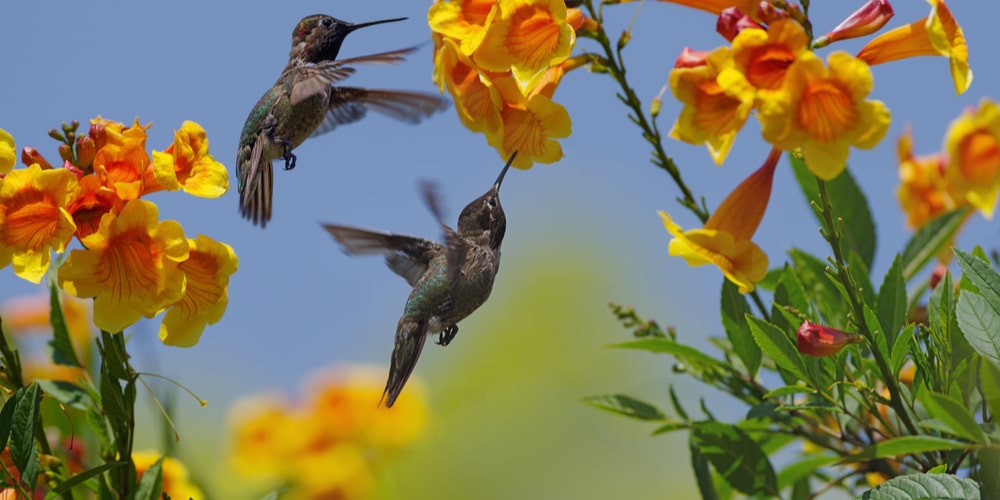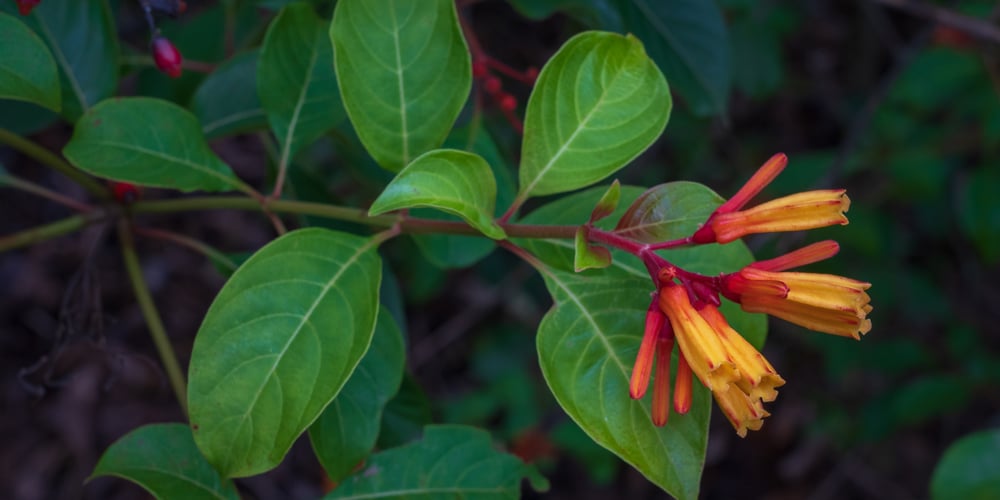Gardeners are often aware of the hummingbird bush – a fast-growing, showy shrub beloved by these tiny birds. Hummingbirds truly are spectacular creatures; their beautiful wings and sweet melodic hums make them a joy to watch.
While these creatures are stunning to the eyes and pleasing to the ears, hummingbirds are crucial to the ecosystem. They are some of the most important pollinators, and their diet consists mainly of insects. One of their favorite foods is aphids, which are destructive pests to many gardens and crops.
With hummingbird bushes in your backyard, you can do your part in supporting these amazing creatures – and have a beautiful garden to boot! Keep reading to learn everything you need to know about hummingbird bush care.

| Botanical Name |
Hamelia Patens |
| Common Name | Hummingbird Bush, Firebush |
| Plant Type | Perennial |
| Flower Color |
Tubular red flowers |
| Size When Mature | 12 – 36 inches tall |
| Bloom Time |
Early Summer |
| Sun Requirements |
Full sun to partial shade, tolerates some shade |
| USDA Hardiness Zones | 9 – 11 |
| Soil PH Range | 6.0 – 8.0 |
| Soil Type |
Well-draining, moist soil |
| Water Needs | Low |
| Native Area | Northern Mexico and South-Central Texas |
What You Need to Know About Hummingbird Bush
A perennial shrub, the hummingbird bush (Hamelia patens) likes to bask in the sun and heat. It’s a shrubby plant that can get up to 36 inches tall, with an upright, sometimes sprawling growth habit. The tubular red flowers are especially attractive to hummingbirds – as well as bees and other pollinators.
Grown for their colorful blooms and attractiveness to wildlife, hummingbird bushes are relatively low-maintenance. They’re heat-tolerant, that little watering is needed once they’re established, and they don’t mind poor soils.
Its foliage is dark green and glossy, with a leathery texture. The leaves are elliptical in shape and have smooth margins. In the fall, the leaves may turn red, yellow, or bronze before falling off.
Although it’s considered to be somewhat weedy and invasive in some areas, the hummingbird bush is not all bad. Its flowers bloom in early summer, providing nectar for pollinators when other flowers are scarce.
How to Care for Hummingbird Bush
Here’s everything you need to know about growing and caring for a thriving hummingbird bush:
Light
The hummingbird bush prefers full sun to partial shade, though it will still bloom in shady areas. The difference is that it won’t be as dense, and the blooms may not be as vibrant.
It’s a heat-loving plant, so the more sun it gets, the better. If you live in a hot climate, protecting these plants from the midday sun will help prevent leaf scorch.
Water and Soil Needs
No matter the kind of soil you have, the hummingbird bush will do just fine in it – even if it’s poor and dry. In fact, even in the heaviest clay soils, it will still grow quite well.
This is a drought-tolerant plant once it’s established, so you won’t need to water it very often. When you do water, make sure to give it a good soaking – about 1” per week. It usually gets its water from rainfall, so supplemental watering is only necessary during periods of drought.
In fact, too much water can be detrimental, leading to root rot. Water only when the top few inches of soil are dry.
Hummingbird bush thrives pretty well in a wide range of soil pH levels, from 6.0 to 8.0.
Temperature Requirements
This plant is native to northern Mexico and south-central Texas, so it’s used to hot climates. It can handle temperatures as high as 95°F without any problems. As for cold snaps, it will do just fine as long as the temperatures don’t dip below 5°F.
Fertilizer
Although not necessary, the best fertilizer for hummingbird bush is a slow-release, all-purpose fertilizer. Any kind of fertilizer will work as long as it’s applied in early spring.
Will the plant survive with minimal or no fertilization? Yes – it can even survive in poor soils. However, take note that its lush foliage and vibrant and large showy blooms will be less impressive without fertilizer.
Common Diseases
Thanks to hummingbirds who often visit these plants, aphids are controlled. However, the plant is susceptible to other pests and diseases, including botrytis blight, leaf spot, and powdery mildew. All these are fungal diseases common in areas with high humidity.
Hummingbird Bush Propagation
Whether you’re looking to attract more feathered visitors, want to fill your landscape with these colorful shrubs, or simply love the challenge of propagation, you’ll be happy to know that it’s pretty easy to do.
There are three ways to propagate hummingbird bush: by seed, softwood cuttings, or semi-ripe cuttings. The easiest and quickest method is through semi-ripe cuttings taken in late summer.
Take approximately 6-inch cuttings from the tips of your hummingbird bush’s branches. Make sure you cut it below a leaf node, with a sterile knife or shears.
Remove the lower leaves of the cutting. This is to ensure that the cutting doesn’t rot when you plant it. Dip the cut end of the stem in rooting hormone, then plant it in a pot filled with moistened potting mix.
Once in the soil, ensure that your cuttings are placed in a well-lit area, away from direct sunlight. Carefully monitor the moisture levels of the soil, as it should always be moist but not soggy. After a few weeks, you should see new growth – this is a sign that your cuttings have taken root.
Wait for a couple more weeks before transplanting your new hummingbird bushes to their permanent homes in the garden.
Related Article: Do Hummingbirds Like Zinnias?
